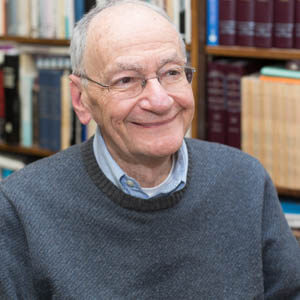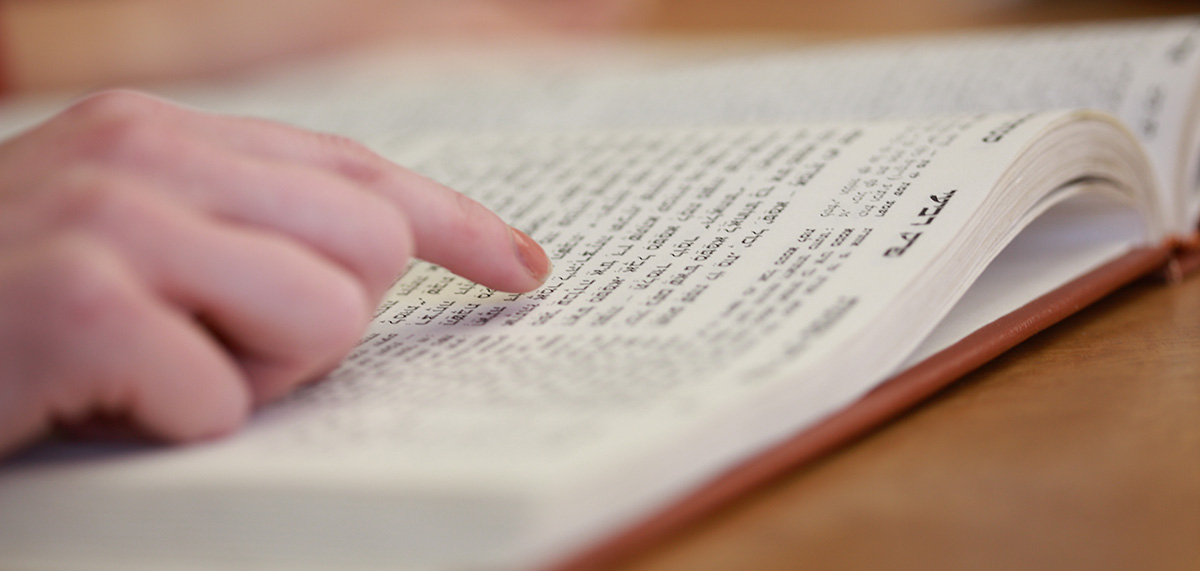Search Results
Back to JTS Torah Online's Main page
Loving Kindness in the Torah
Nov 6, 1999 By Ismar Schorsch | Commentary | Hayyei Sarah
We don’t pick spouses for our children anymore. But if we did, what trait would we single out as the best indicator of a happy marriage?
Read More
Welcoming the Stranger
Oct 30, 1999 By Matthew Berkowitz | Commentary | Vayera
Parashat Va-Yera opens with two seemingly unrelated narratives: first, ‘three men’ appear mysteriously to Abraham, bearing the news that his wife, Sarah, will soon conceive. Next we read of God’s destruction of the cities of S’dom and Amora for their immorality and corruption.
Read More
Abraham’s Struggle to See
Oct 23, 1999 By Matthew Berkowitz | Commentary | Lekh Lekha
Visual perception figures prominently in the week’s parasha, Parashat Lekh L’kha . Indeed, the verb ‘to see’, re’eh, repeats itself time and again – declaring its presence as the leitwort (‘leading word’ — a concept central to Martin Buber’s writings on the Bible) of the Abraham narrative. God commands Abraham to go forth “from your father’s house to the land that I will let you see” (Gen. 12:1); Abraham is concerned for his life “when the Egyptians see” Sarah (Gen. 12:12); and after the division of land between Lot and Abraham, God says to Abraham “Pray, lift up your eyes and see from the place where you are, to the north, to the Negev, to the east, and to the Sea” (Gen. 13:14). And although the Torah is silent on the particulars of God’s election of Abraham, many commentators credit Abraham’s keen sense of observation for pointing him in the ‘right’ direction. As will become evident through traditional and modern commentaries alike, this visual perception is at once Abraham’s greatest strength and most profound weakness.
Read More
The Path to Repentance
Oct 16, 1999 By Ismar Schorsch | Commentary | Noah
The first eleven chapters of Genesis make for dismal reading. In contrast to the grandeur and harmony of the heavens, the primeval history of humanity is wracked with violence, one moral debacle after another. God quickly comes to regret the creation of unfettered sentient beings and decides to start over, though with no better results. Both before and after the flood, God concludes ruefully that the penchant of humankind to do evil is beyond dispute (6:5, 8:21). The second time, God chose to be more directive, explicitly forbidding murder and the ingesting of blood, while permitting the consumption of meat.
Read More
Genesis As Hindsight
Oct 9, 1999 By Ismar Schorsch | Commentary | Bereishit
The opening chapter of a book is often the last to be written. At the outset, the author may still lack a clear vision of the whole. Writing is the final stage of thinking, and many a change in order, emphasis, and interpretation is the product of wrestling with an unruly body of material. Only after all is in place does it become apparent what kind of introduction the work calls for.
Read More
The Religious Value of Joy
Sep 24, 1999 By Ismar Schorsch | Commentary | Sukkot
Sukkot at the Seminary is the loveliest of festivals. Rabbinical students are back from their high holiday jobs. The tension of officiating for the first or second time has dissipated and the gravity of the season lifted. Joined in community, we fill the synagogue with the songs of Hallel and the pageantry of the Lulav. A feeling of thanksgiving is in the air. Together we take our meals in the richly decorated Sukkot in the quadrangle which invigorate our sense of the natural world. Conversation, singing and a bit of Torah from an invited speaker enhance this fare.
Read More
A Meditation on Prayer
Sep 11, 1999 By Ismar Schorsch | Commentary | Rosh Hashanah
According to the Shulhan Arukh, the 16th-century halakhic code which still governs much of Jewish practice, Jews in the synagogue on the High Holy Days are permitted to raise their voices while praying. The reason given intrigues me: because everyone has a mahzor, our neighbor’s voice will not confuse us. Elsewhere, the Shulhan Arukh makes it clear that on all other days of the year, we are expected to address God in the synagogue silently, so as not to disturb those sitting nearby. And this despite a general counsel to actually pronounce the words of our prayers as we recite them. They are to be audible but only to us (Oreh Hayyim 582:9; 101:2-3).
Read More
The Power of Tish’ah Be’av
Jul 17, 1999 By Ismar Schorsch | Commentary | Devarim | Tishah Be'av
The Shabbat before Tisha b’Av (the 24-hour fast day on the ninth of Av) bears the name Shabbat Hazon (the Sabbath of Vision). It derives from the first word of the haftara: “The vision [hazon] of Isaiah son of Amoz that he beheld concerning Judah and Jerusalem… (Isaiah 1:1).” In English the translation conveys a note of irony, because the word “vision” tends to connote a depiction of beauty and inspiration, whereas Isaiah is delivering a stern reprimand of the hypocrisy and injustice of Judah in the late eighth century B.C.E. The Hebrew word “hazon”, in contrast, is neutral, stressing the divine source of the vision rather than what is depicted. The prophet is a seer by virtue of his access to an experience of revelation, irrespective of its content.
Read More
The Power of Jewish History
Jul 10, 1999 By Ismar Schorsch | Commentary | Masei | Mattot
No Jewish historian ever had a greater impact on his time than Simon Dubnov. He died at the hands of the Nazis in Riga in December 1941 at the age of 81. Because he was too frail and infirm to deport, they shot him in the ghetto. Those who witnessed the murder reported that Dubnov’s last words were, “Jews, write it down.” And they did, in Kovno, Warsaw, Lodz and elsewhere. In his spirit, Jews organized collective and clandestine efforts to record the many terrifying faces of the Final Solution. Unarmed and unaided, they found solace in assembling the evidence that would one day convict their mass murderers in the court of human history.
Read More
Entering the Covenant
Jul 3, 1999 By Ismar Schorsch | Commentary | Pinehas
This past Shabbat the Schorsch family celebrated the bris of their seventh grandchild. The previous Shabbat, our younger daughter had given birth to her second child. Once again we made use of the small, faded blue velvet kippah, hand sewn and embossed with my Hebrew name by my father’s artist friend in Germany, Fanny Dessau. As it covered my head at my bris, it has now graced the bris of our son and that of three out of four of our grandsons. To me, it is not just a treasured artifact of family pride, but also a symbol of just how valuable is the transmission of consciousness and culture from one generation to the next.
Read More
My Father’s Legacy
Jul 1, 1999 By Ismar Schorsch | Commentary | Shelah Lekha
From the beginning, the culmination was to have been a land of their own. The progeny of Abraham, grown from a clan into a nation, would be freed from Egypt and returned to the land of Canaan, where once their ancestors briefly dwelled. But on the southern border at Kadesh, the people succumbed to a failure of nerve and decided to abort. The report of ten of the twelve spies sent by Moses to scout the land utterly demoralized them: “We looked liked grasshoppers to ourselves, and so we must have looked to them [the inhabitants of Canaan] (Numbers 14:33).” Fear overwhelmed their newly found faith, which rested largely on miracles rather than conviction. Clearly, in a single generation, God could take Israel out of slavery, but not the mindset of a slave out of Israel. A steady diet of miracles had merely perpetuated their state of dependency.
Read More
Moses the Man
Jun 19, 1999 By Ismar Schorsch | Commentary | Korah
Nowhere does the Torah provide us with a single, well-rounded profile of the figure who dominates most of its narrative. We, its readers, need to gather for ourselves the traits of Moses, alluded to in piecemeal fashion, into an integrated profile. Plot mediates the contours of character. Last week, for example, the Torah depicted Moses as the most humble of men in recounting the recriminations brought against him publicly by his own brother and sister (Numbers 12). In the stories from the time before he ascended to the leadership of his nation, he exhibits a deep-seated inability to countenance acts of injustice (Exodus 2:11-13, 16-17; 3:7-9). Given to outbursts of anger against the inconstancy of the Israelites (Exodus 32:19-28), he also is moved repeatedly by compassion to intercede with God on behalf of those who have transgressed (Exodus 32:30-32; Numbers 12:13; 14:11-20).
Read More
Miriam’s Death
Jun 16, 1999 By Ismar Schorsch | Commentary | Balak | Hukkat
Biblical narrative begs for reader participation. Time and again we come across a story short on context, background and human emotions, traces of an event barely recalled and crying out for elucidation. This week’s parasha contains a gem of an example.
Read More
The Gifts of Jewish Unity
May 29, 1999 By Ismar Schorsch | Commentary | Naso | Hanukkah
We modern readers have little patience for repetition. To us it marks the absence of novelty and we hurry on. The end of this week’s parasha is a particularly trying instance: an extended list of twelve tribal chieftains dedicating the Tabernacle cult each with his own gift. But the gifts are absolutely identical: “one silver bowl and one silver basin, each filled with choice flour and oil for cereal offerings, one gold ladle filled with incense and the same number and kind of sacrificial animals (Jacob Milgrom, JPS Torah Commentary, Numbers, p. 53).” Individuality expresses itself barely in the fact that each leader is duly named and allotted his own day for bringing his gift. But the Torah feels obliged to repeat with relentless persistence the details of each gift, adding up to a numbing total of 76 verses of unrelieved sameness (Numbers 7:10–86).
Read More
Fulfilling the Commandments
May 1, 1999 By Ismar Schorsch | Commentary | Emor
Piety and morality diverged once again recently when Rabbi Hertz Frankel, the English studies principal of Beth Rachel (the network of Satmar girls’ schools in the Brooklyn neighborhood of Williamsburg), pleaded guilty to embezzling more than six million dollars of public funds over nearly two decades for the welfare of his employer. Despite a light sentence –– three years of unsupervised probation and a fine of one million dollars on Beth Rachel –– Rabbi Frankel was unrepentant. “The end justifies the means,” he told the New York Times, which I take to mean that he believed the Jewish children in his care were more deserving of the money than the non–Jewish children, no less impoverished and deprived, who lived in his school district.
Read More
The Altar at Home
Mar 20, 1999 By Ismar Schorsch | Commentary | Vayikra
I have a deeply personal attachment to parashat Vayikra. Many years ago it was the parasha on which my son celebrated his bar-mitzva. Though he attended a day school, I prepared him for the occasion as my father had once prepared me, and as my son will one day prepare his children. For half a year, I would corral him regularly to teach him the Torah portion according to the eastern European cantillation common in American and the haftara according to the uncommon German cantillation on which I was raised.
Read More
Wearing the Crowns of Heaven
Feb 27, 1999 By Ismar Schorsch | Commentary | Tetzavveh | Purim
Many a busy street corner of Manhattan has served on occasion as the stump of a preacher who speaks in the name of God. With the countdown to the millennium, the scene will only occur with greater frequency. Yet most passersby don’t tarry for a moment. The mere claim to revelation carries no weight.
Read More
The Experience of Revelation
Feb 13, 1999 By Ismar Schorsch | Commentary | Mishpatim | Shabbat Shekalim
With exuberance and certainty, the young Heinrich Graetz, not yet 30 but soon to become the greatest Jewish historian of the nineteenth century, made a distinction between Judaism and paganism that would in time become commonplace: “To the pagan, the divine appears within nature as something observable to the eye. He becomes conscious of it as something seen. In contrast, to the Jew who knows that the divine exists beyond, outside of, and prior to nature, God reveals Himself through a demonstration of His will, through the medium of the ear. The human subject becomes conscious of the divine through hearing and obeying. Paganism sees its god, Judaism hears Him; that is, it hears the commandments of His will.”
Read More
Do You Believe in God?
Feb 6, 1999 By Ismar Schorsch | Commentary | Yitro
Martin Buber tells the story of an unexpected visit by an elderly English clergyman in the spring of 1914. A simple Christian of deep faith, he had done much good for the nascent Zionist movement in the days of Theodor Herzl and Buber knew him well. What brought him to Buber that particular day was his foreboding of an imminent outbreak of war worldwide, based not on any public or secret sources of information, but on his own careful recalculation of the age-old prophecies of Daniel. When the presentation ended, Buber took his guest back to the railroad station. Before they parted, the clergyman grasped Buber’s arm and said to him with utmost gravity: “Dear friend, we are living in a great time. Tell me: Do you believe in God?”
Read More
Balancing Emotional and Rational Approaches
Jan 30, 1999 By Morton M. Leifman z”l | Commentary | Beshallah
This Shabbat celebrates music. Some communities have developed the lovely custom on Shabbat Shira of distributing special food for the birds, those providers of musical gifts to humanity. The Beshalah Torah reading contains the passionate hymn which our ancestors chanted after crossing the Sea of Reeds in safety and witnessing the destruction of their pursuing enemies. Our tradition is to stand during the reading of the hymn, for the leader to use special musical tropes during the chanting and for the congregation to join in the singing of a number of the verses. It is intended to be a dramatic performance. In some Hassidic communities the chanting was followed by a ritual dance to reenact symbolically the jumping into the waters of the sea and the emerging in safety. Thus, music and drama are used as an integral part of the emotional components of the religious experience.
Read MoreSUBSCRIBE TO TORAH FROM JTS
Our regular commentaries and videos are a great way to stay intellectually and spiritually engaged with Jewish thought and wisdom.




